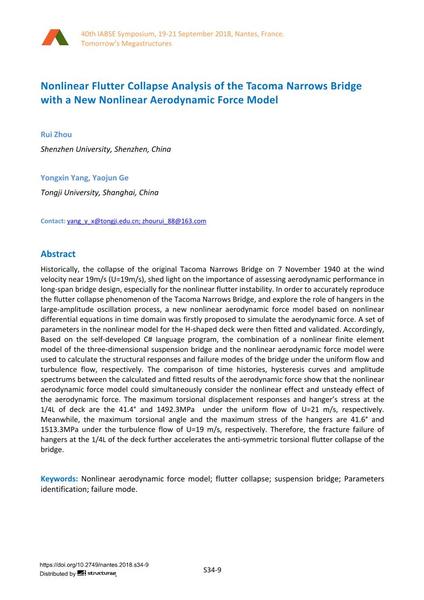Nonlinear Flutter Collapse Analysis of the Tacoma Narrows Bridge with a New Nonlinear Aerodynamic Force Model

|
|
|||||||||||
Bibliografische Angaben
| Autor(en): |
Rui Zhou
(Shenzhen University, Shenzhen, China)
Yongxin Yang (Tongji University, Shanghai, China) Yaojun Ge (Tongji University, Shanghai, China) |
||||
|---|---|---|---|---|---|
| Medium: | Tagungsbeitrag | ||||
| Sprache(n): | Englisch | ||||
| Tagung: | IABSE Symposium: Tomorrow’s Megastructures, Nantes, France, 19-21 September 2018 | ||||
| Veröffentlicht in: | IABSE Symposium Nantes 2018 | ||||
|
|||||
| Seite(n): | S34-9 | ||||
| Anzahl der Seiten (im PDF): | 7 | ||||
| DOI: | 10.2749/nantes.2018.s34-9 | ||||
| Abstrakt: |
Historically, the collapse of the original Tacoma Narrows Bridge on 7 November 1940 at the wind velocity near 19m/s (U=19m/s), shed light on the importance of assessing aerodynamic performance in long-span bridge design, especially for the nonlinear flutter instability. In order to accurately reproduce the flutter collapse phenomenon of the Tacoma Narrows Bridge, and explore the role of hangers in the large-amplitude oscillation process, a new nonlinear aerodynamic force model based on nonlinear differential equations in time domain was firstly proposed to simulate the aerodynamic force. A set of parameters in the nonlinear model for the H-shaped deck were then fitted and validated. Accordingly, Based on the self-developed C# language program, the combination of a nonlinear finite element model of the three-dimensional suspension bridge and the nonlinear aerodynamic force model were used to calculate the structural responses and failure modes of the bridge under the uniform flow and turbulence flow, respectively. The comparison of time histories, hysteresis curves and amplitude spectrums between the calculated and fitted results of the aerodynamic force show that the nonlinear aerodynamic force model could simultaneously consider the nonlinear effect and unsteady effect of the aerodynamic force. The maximum torsional displacement responses and hanger’s stress at the 1/4L of deck are the 41.4° and 1492.3MPa under the uniform flow of U=21 m/s, respectively. Meanwhile, the maximum torsional angle and the maximum stress of the hangers are 41.6° and 1513.3MPa under the turbulence flow of U=19 m/s, respectively. Therefore, the fracture failure of hangers at the 1/4L of the deck further accelerates the anti-symmetric torsional flutter collapse of the bridge. |
||||
| Stichwörter: |
Hängebrücke Versagensart
|
||||
